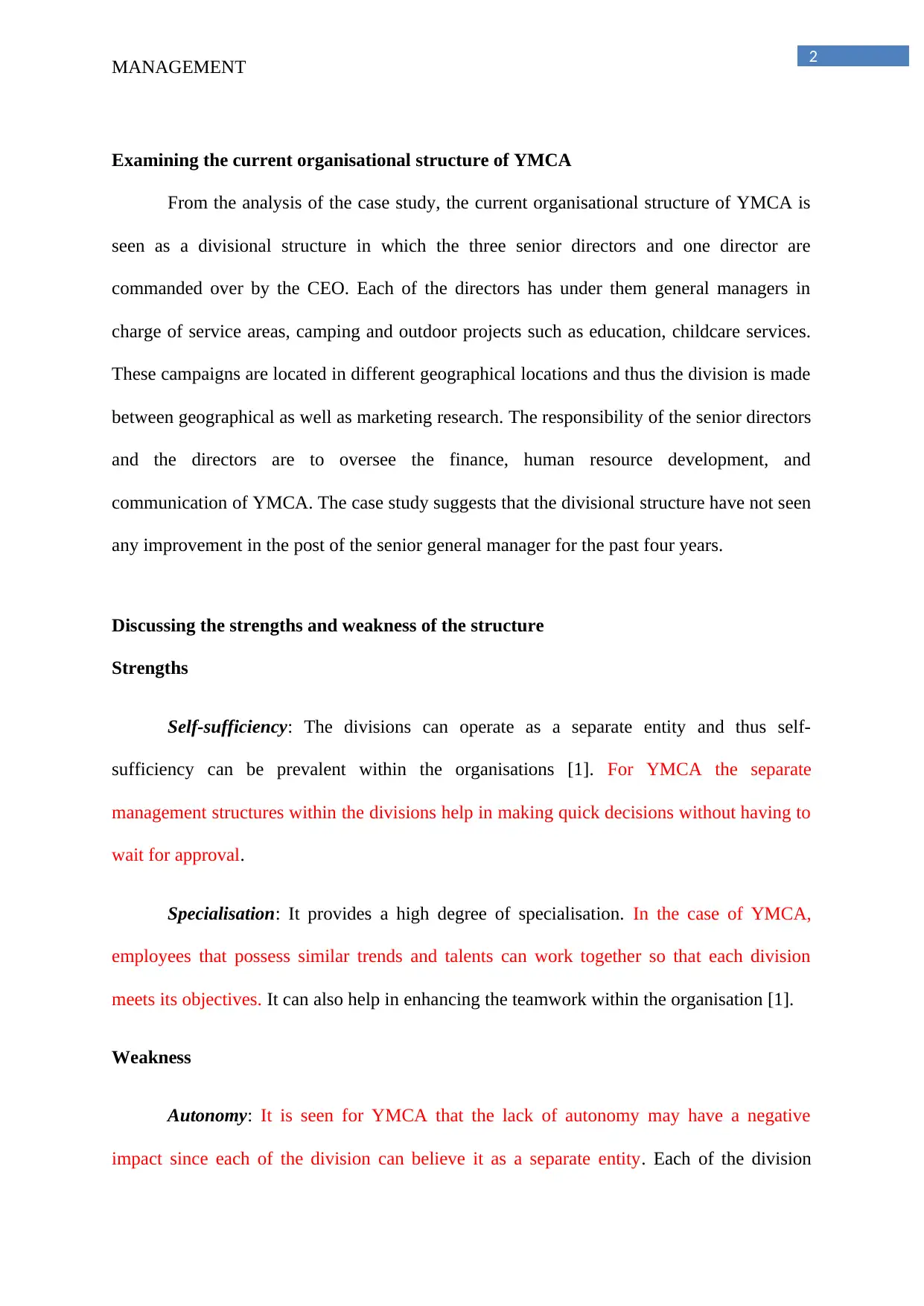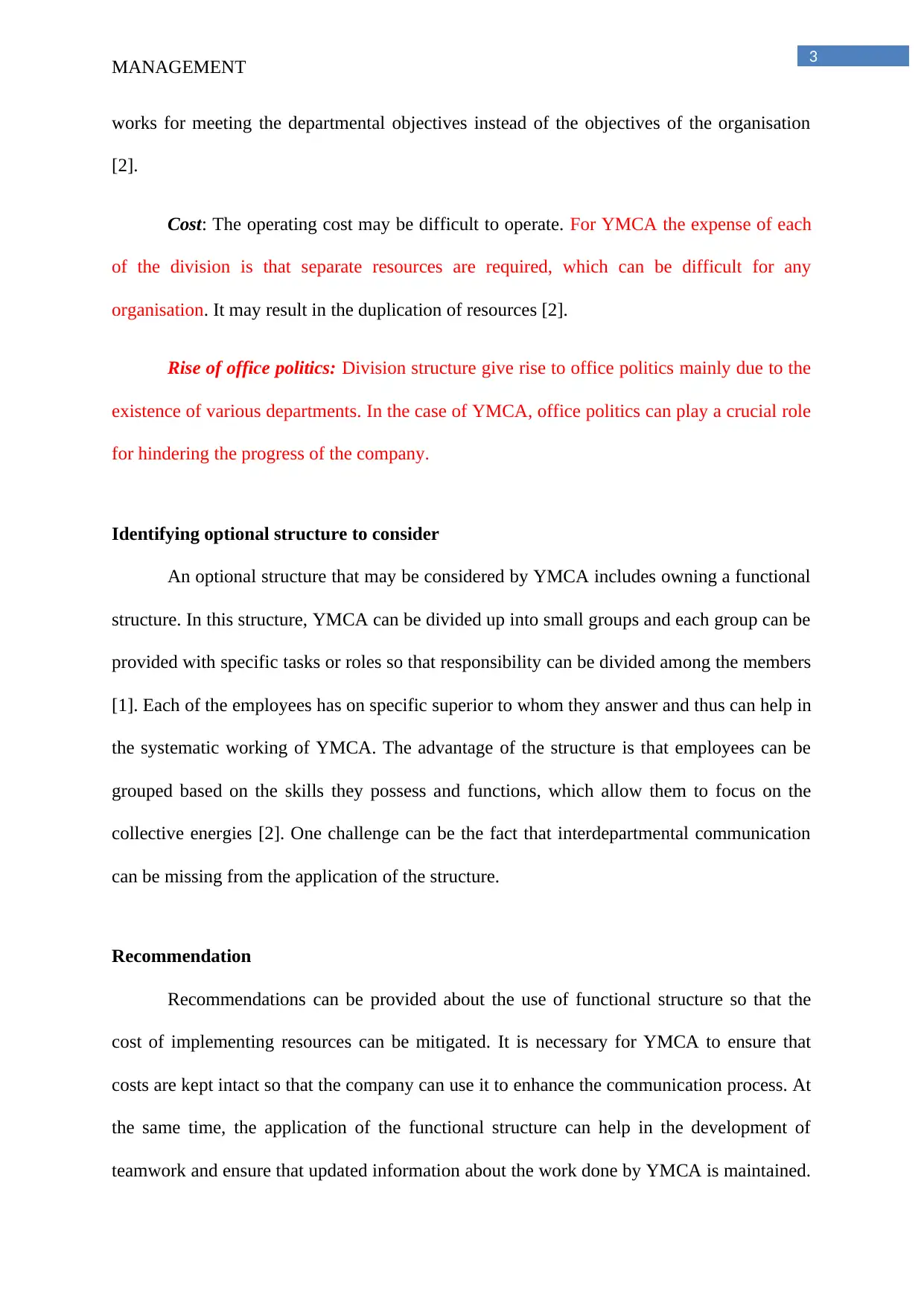YMCA of London, Ontario: Organizational Structure Analysis and Report
VerifiedAdded on 2022/11/11
|6
|741
|269
Report
AI Summary
This report provides an analysis of the YMCA of London's organizational structure, examining it as a divisional structure with a CEO, senior directors, and general managers. The report discusses the strengths, such as self-sufficiency and specialization, and weaknesses, including a lack of autonomy, high costs, and the potential for office politics. It identifies a functional structure as an alternative, outlining its advantages and challenges. The report recommends implementing a functional structure to mitigate costs, enhance communication, and foster teamwork, while also addressing the importance of managing office politics. The analysis is based on the provided case study, offering insights into the YMCA's operations and suggesting strategic improvements for future business prospects.

Running head: MANAGEMENT
Management
Name of the student
Name of the university
Author’s note
Management
Name of the student
Name of the university
Author’s note
Paraphrase This Document
Need a fresh take? Get an instant paraphrase of this document with our AI Paraphraser

1
MANAGEMENT
Table of Contents
Examining the current organisational structure of YMCA........................................................2
Discussing the strengths and weakness of the structure.............................................................2
Identifying optional structure to consider..................................................................................3
Recommendation........................................................................................................................3
Reference....................................................................................................................................4
MANAGEMENT
Table of Contents
Examining the current organisational structure of YMCA........................................................2
Discussing the strengths and weakness of the structure.............................................................2
Identifying optional structure to consider..................................................................................3
Recommendation........................................................................................................................3
Reference....................................................................................................................................4

2
MANAGEMENT
Examining the current organisational structure of YMCA
From the analysis of the case study, the current organisational structure of YMCA is
seen as a divisional structure in which the three senior directors and one director are
commanded over by the CEO. Each of the directors has under them general managers in
charge of service areas, camping and outdoor projects such as education, childcare services.
These campaigns are located in different geographical locations and thus the division is made
between geographical as well as marketing research. The responsibility of the senior directors
and the directors are to oversee the finance, human resource development, and
communication of YMCA. The case study suggests that the divisional structure have not seen
any improvement in the post of the senior general manager for the past four years.
Discussing the strengths and weakness of the structure
Strengths
Self-sufficiency: The divisions can operate as a separate entity and thus self-
sufficiency can be prevalent within the organisations [1]. For YMCA the separate
management structures within the divisions help in making quick decisions without having to
wait for approval.
Specialisation: It provides a high degree of specialisation. In the case of YMCA,
employees that possess similar trends and talents can work together so that each division
meets its objectives. It can also help in enhancing the teamwork within the organisation [1].
Weakness
Autonomy: It is seen for YMCA that the lack of autonomy may have a negative
impact since each of the division can believe it as a separate entity. Each of the division
MANAGEMENT
Examining the current organisational structure of YMCA
From the analysis of the case study, the current organisational structure of YMCA is
seen as a divisional structure in which the three senior directors and one director are
commanded over by the CEO. Each of the directors has under them general managers in
charge of service areas, camping and outdoor projects such as education, childcare services.
These campaigns are located in different geographical locations and thus the division is made
between geographical as well as marketing research. The responsibility of the senior directors
and the directors are to oversee the finance, human resource development, and
communication of YMCA. The case study suggests that the divisional structure have not seen
any improvement in the post of the senior general manager for the past four years.
Discussing the strengths and weakness of the structure
Strengths
Self-sufficiency: The divisions can operate as a separate entity and thus self-
sufficiency can be prevalent within the organisations [1]. For YMCA the separate
management structures within the divisions help in making quick decisions without having to
wait for approval.
Specialisation: It provides a high degree of specialisation. In the case of YMCA,
employees that possess similar trends and talents can work together so that each division
meets its objectives. It can also help in enhancing the teamwork within the organisation [1].
Weakness
Autonomy: It is seen for YMCA that the lack of autonomy may have a negative
impact since each of the division can believe it as a separate entity. Each of the division
⊘ This is a preview!⊘
Do you want full access?
Subscribe today to unlock all pages.

Trusted by 1+ million students worldwide

3
MANAGEMENT
works for meeting the departmental objectives instead of the objectives of the organisation
[2].
Cost: The operating cost may be difficult to operate. For YMCA the expense of each
of the division is that separate resources are required, which can be difficult for any
organisation. It may result in the duplication of resources [2].
Rise of office politics: Division structure give rise to office politics mainly due to the
existence of various departments. In the case of YMCA, office politics can play a crucial role
for hindering the progress of the company.
Identifying optional structure to consider
An optional structure that may be considered by YMCA includes owning a functional
structure. In this structure, YMCA can be divided up into small groups and each group can be
provided with specific tasks or roles so that responsibility can be divided among the members
[1]. Each of the employees has on specific superior to whom they answer and thus can help in
the systematic working of YMCA. The advantage of the structure is that employees can be
grouped based on the skills they possess and functions, which allow them to focus on the
collective energies [2]. One challenge can be the fact that interdepartmental communication
can be missing from the application of the structure.
Recommendation
Recommendations can be provided about the use of functional structure so that the
cost of implementing resources can be mitigated. It is necessary for YMCA to ensure that
costs are kept intact so that the company can use it to enhance the communication process. At
the same time, the application of the functional structure can help in the development of
teamwork and ensure that updated information about the work done by YMCA is maintained.
MANAGEMENT
works for meeting the departmental objectives instead of the objectives of the organisation
[2].
Cost: The operating cost may be difficult to operate. For YMCA the expense of each
of the division is that separate resources are required, which can be difficult for any
organisation. It may result in the duplication of resources [2].
Rise of office politics: Division structure give rise to office politics mainly due to the
existence of various departments. In the case of YMCA, office politics can play a crucial role
for hindering the progress of the company.
Identifying optional structure to consider
An optional structure that may be considered by YMCA includes owning a functional
structure. In this structure, YMCA can be divided up into small groups and each group can be
provided with specific tasks or roles so that responsibility can be divided among the members
[1]. Each of the employees has on specific superior to whom they answer and thus can help in
the systematic working of YMCA. The advantage of the structure is that employees can be
grouped based on the skills they possess and functions, which allow them to focus on the
collective energies [2]. One challenge can be the fact that interdepartmental communication
can be missing from the application of the structure.
Recommendation
Recommendations can be provided about the use of functional structure so that the
cost of implementing resources can be mitigated. It is necessary for YMCA to ensure that
costs are kept intact so that the company can use it to enhance the communication process. At
the same time, the application of the functional structure can help in the development of
teamwork and ensure that updated information about the work done by YMCA is maintained.
Paraphrase This Document
Need a fresh take? Get an instant paraphrase of this document with our AI Paraphraser

4
MANAGEMENT
Hence, the change can help in enhancing the business prospects of YMCA. Office politics
need to be kept under check mainly because the company aims at developing an environment
that helps in maintaining the balance between the employee and employer relationships.
MANAGEMENT
Hence, the change can help in enhancing the business prospects of YMCA. Office politics
need to be kept under check mainly because the company aims at developing an environment
that helps in maintaining the balance between the employee and employer relationships.

5
MANAGEMENT
Reference
[1]. Ramanadham VV, editor. Public enterprise: studies in organisational structure.
Routledge; 2019 Feb 11.
[2]. Horch HD. The intermediary organisational structure of voluntary associations.
Voluntary Sector Review. 2018 Mar 31;9(1):55-72.
MANAGEMENT
Reference
[1]. Ramanadham VV, editor. Public enterprise: studies in organisational structure.
Routledge; 2019 Feb 11.
[2]. Horch HD. The intermediary organisational structure of voluntary associations.
Voluntary Sector Review. 2018 Mar 31;9(1):55-72.
⊘ This is a preview!⊘
Do you want full access?
Subscribe today to unlock all pages.

Trusted by 1+ million students worldwide
1 out of 6
Related Documents
Your All-in-One AI-Powered Toolkit for Academic Success.
+13062052269
info@desklib.com
Available 24*7 on WhatsApp / Email
![[object Object]](/_next/static/media/star-bottom.7253800d.svg)
Unlock your academic potential
Copyright © 2020–2025 A2Z Services. All Rights Reserved. Developed and managed by ZUCOL.





